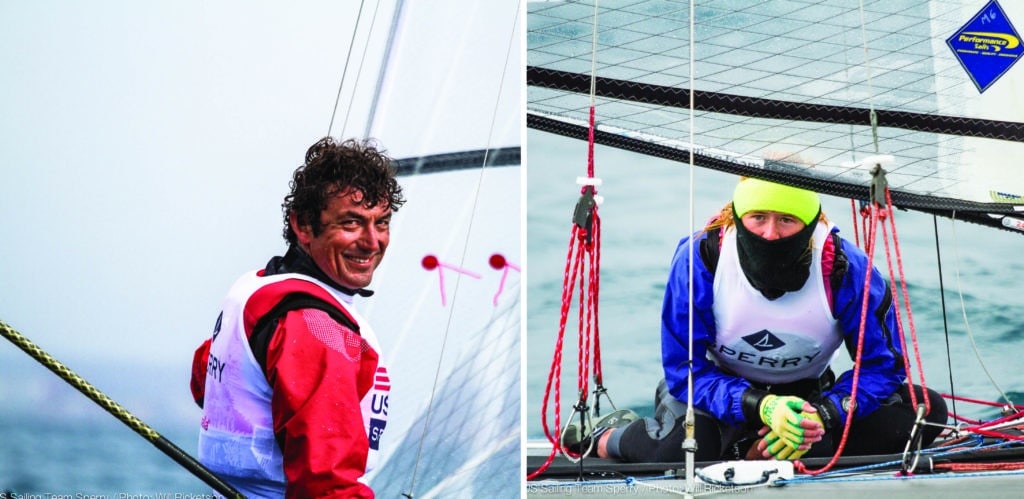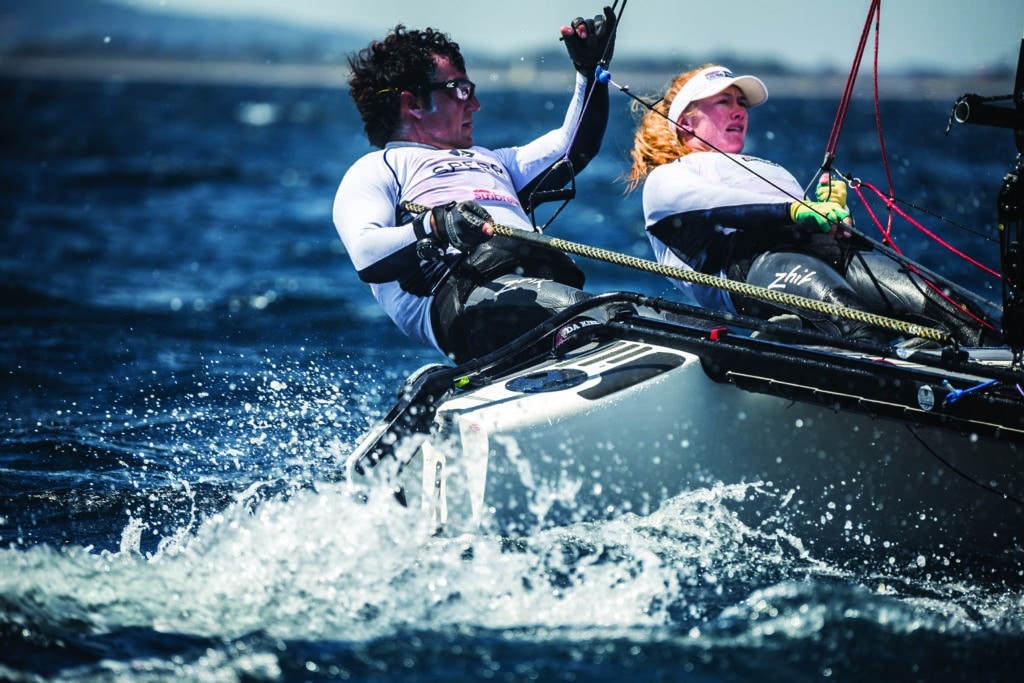
in a small gated community in Clearwater, Florida, it’s easy to pick out the sailor’s house. Boat trailers obstruct the tree-lined street out front, and the disassembled pontoons of at least two Nacra 17s consume the narrow driveway. Inside, wetsuits hang from the ceiling rafters, drying. Bora Gulari, barefoot with coffee in hand, squints into early-morning rays from the front porch of the bungalow. He sports the deep tan of a waterman, and his mop of black curls hangs over his eyes. Pushing up the sleeves on a worn-out gray hoodie bearing the American flag and “GULARI” across the back, he shakes my hand and asks me for a ride to the local Publix to pick up laundry detergent.
Gulari is one half of the newborn Nacra 17 pairing on US Sailing Team Sperry. The other half is Louisa Chafee, the 24-year-old recent Brown University graduate and daughter of former Rhode Island governor Lincoln Chafee. Their campaign is so new that they’re still sorting through the more trivial logistics, like how many Tide pods it takes to get them through a week of sailing. Gulari and Chafee have been an official team for exactly a month and have sailed in only two major regattas. They’ve earned the one and only American Nacra 17 berth for Rio.
Though the pairing happened seemingly out of the blue, Gulari and Chafee have been training in the same circle for a long time with different teammates. “Both of them were in less strong teams before, so putting those two together was inevitable,” says coach Randy Smyth, a silver medalist in the Tornado. “Neither of them would have been trial-winning material unless they teamed up.”
While training in October 2015, Gulari’s then-crew Solvig Sayre was injured, so Gulari took the place of Chafee’s skipper, Ian Liberty, on one of the boats for an hour. “Right away, we knew it was good,” says Chafee. “We gelled really nicely, and it wasn’t like getting into a boat with a stranger.”
Gulari was instantly impressed. “Louisa is the best crew I’ve ever sailed with,” he says. “She’s fast, she’s nimble, and she has tons of positive energy. She makes sure the entire team is motivated, and it’s a good vibe to feel. It’s what you want in your partner.”
Gulari and Chafee committed as a team in mid-January. The two practiced together for less than two weeks, focusing almost entirely on boatspeed rather than practice races and tactics, with which both have plenty of experience.
Their first appearance in international competition was January’s Sailing World Cup Miami, one of two Olympic selection events. On flat water, Gulari and Chafee’s superior speed vaulted them into the lead in the selection trials, eight points ahead of Mark and Carolina Mendelblatt, second in the series.

At the next selection event a week later, the Nacra 17 World Championship in Clearwater, the scene was far less idyllic. Short, steep chop and knockdown windspeeds challenged the new team. The complications of being part of a larger team added to off-water distractions for Gulari and Chafee.
“Things went down at the regatta that we don’t want to dwell on, but they affected our performance,” says Chafee, referring to the interteam dynamics that were foreign to them. “When we came off the water, we didn’t even know if we had the spot because our last race was so bad.”
In an effort to depower the boat, Gulari tinkered with the Nacra’s daggerboards in the early days of the worlds. As an engineer and consummate tweaker, he couldn’t resist. “I was playing around with the idea that if you had too much lift and the boat was pitching a lot, would the foils actually stall and produce a performance detriment?” says Gulari. “Turned out, not the case.” After posting results in the low 20s and high 30s in the first two days of racing, Gulari readjusted the boards.
Despite equipment difficulties, the pair rallied and finished 31st overall — behind two other American teams in the event, but good enough for Olympic selection. In doing so, they edged out other teams that had been training for years.
“The other teams aren’t something I concerned myself with,” says Gulari. “I assume there might be some emotion there, but I can’t speak for them. At the same time, I want to sail against the best people I can and beat the best guys out there, and they should feel that way too. Who cares if you’re the best fish in a small pond? That’s not the goal.”
Gulari and Chafee are what Smyth describes as “the furthest thing you could get from clones,” but their differences define them. “Louisa is a dynamic weight-room girl, who hoists the spinnaker and it goes up so fast,” says Smyth. “She knows what she’s doing in a Nacra. You mix that in with Bora, a live-on-the-water sailor, whose brain is always going 80 miles an hour in 10 different directions. They understand that it’s not an easy road, and both of them contribute differently to make a strong team.”
Chafee has a feel for the Nacra because of her experience as both a crew and a skipper. Gulari, on the other hand, is a Moth world champion and can make the technical adjustments necessary to improve performance based on Chafee’s feedback. “I can tell Bora that something feels off, and we’ll figure it out together,” she says. “I’m able to provide insight into moving through the boat and the actual sailing of the Nacra. Bora is teaching me a lot about the technical side of things and about trimming the main.”
Gulari didn’t have his sights on an Olympic campaign until recently, but once he became dedicated, his persistence was unrelenting. For him, the campaign is a soul-searching endeavor. “I bleed red, white and blue, and this is the most pure form of representing my country,” he says. “Bora really started talking about doing an Olympic campaign in 2014 or 2015,” says Rolex Yachtsman of the Year and 470 silver medalist Steve Benjamin, who has sailed with Gulari in a variety of offshore races over the course of five years. “He had been sailing Moths at the time, and it was a logical progression for him to make. He’s incredibly energetic and absolutely committed to the success of the boat that he’s on.”
The Olympics have been a goal of Chafee’s since she graduated from Brown in 2014. “I wanted to keep sailing, and the only way I knew how was through an Olympic campaign,” she says. “The more I did it, the more I wanted to make it happen. The goal became not only going to the Games, but to medal, and gold goes well with my hair.”
Chafee might be the fair maiden riding in with the dark horse Gulari, but she’s far from a damsel in distress. “Louisa’s energy is relaxed and then, when she gets on the boat, she comes alive with a competitive spirit and throws her entire physical ability into the boat,” says Smyth.
“We had a crash the first practice day in Clearwater,” says Gulari. “Louisa was either on the shroud or board, and I slid into her and hit her really hard. Right away I thought, ‘Here we go, I just broke the crew the day before the second part of the trials.’ Luckily she was fine, but the Nacra is a crew-eater. They work their butts off.”
At 5 feet 5 inches, Chafee is shorter and lighter than what she sees as an ideal Nacra crew. “Bora and I joke that the crew is the mitochondria of the Nacra,” she says. “You have to have raw, physical power.”
This means long hours of training in the gym to strengthen her biceps, shoulders and forearms so she can play the sheets and halyards. She focuses on endurance and flexibility as well, to keep her moving across the boat consistently over the five to six full days of racing. Though she’s shorter than many crews, her long legs give her the powerful base she needs.
All that work in the gym is a major time commitment, so Gulari and Chafee are changing their training strategy. “Moving forward, we’re making my strength a priority,” says Chafee. “I don’t need to spend four hours in a debrief after practice. I should be spending that time building strength. These little things come with being a new team. We have to figure out how to structure our days and weeks.”
As for the brevity of their pre-Olympic preparation time, Gulari and Chafee are unfazed. “I’m typically a one-week-at-a-time guy, but obviously there’s much more planning that needs to go into this,” says Gulari. “The virtue of having such great supporters is that they know my strengths and weaknesses and can help us that way. I’m more of a ‘let’s just go sailing and we’ll sort it out later’ kind of guy.”
His and Chafee’s support team includes Smyth; regatta coach Jonathan McKee; the US Sailing Team Sperry staff; Chafee’s mother, who is handling logistics; and Gulari’s girlfriend’s family, helping to manage campaign finances. Sarah Newberry, whom Gulari and Chafee beat out for the trials spot, has offered to help them train. “She has worked so hard for so long — she qualified our country — and for her to not go to the Games but still want to support the U.S. team is impressive,” says Chafee.
Neither Chafee nor Gulari has sailed in Guanabara Bay, but they plan to attend US Sailing Team training camps before the Games. “I enjoy variable conditions, so it shouldn’t be as much of a challenge,” says Gulari. “Everyone says they’re going to give me notes and that I need to learn about the racecourses, but honestly, it’s just another body of water.”
They both say their goal is to help Team USA avoid a repeat of the London 2012 Olympics, where the Americans failed to earn any sailing medals. Since Clearwater, they’ve sailed in Palma in similar conditions and finished 12th. “We’re making huge strides in the international fleet in a short amount of time,” says Chafee. “We’re now fine-tuning our strategy and are feeling confident in being able to use our remaining time to the maximum.” Their schedule until August runs one to two weeks of training, a regatta, and then a few days or a week off, right up to the start of the Games. US Sailing Team Sperry helped Gulari and Chafee plan their training and time-off schedule so they would arrive in Rio at their performance peak.
Chafee says she’s looking forward to the journey, but one of her strongest motivators is the opportunity to trim the Stars and Stripes-themed spinnaker at the Olympics. The goal was on one of her motivational sticky notes that she posted on her computer during the trials, and she’s carrying it all the way to the end. “Now that we’re the only American boat, we’re ready to do the flag proud,” she says.
They’ve come from behind to take the reins once, and with even more time to prepare and practice together before the Games, the international Nacra 17 class now has a sleeper among its ranks.









